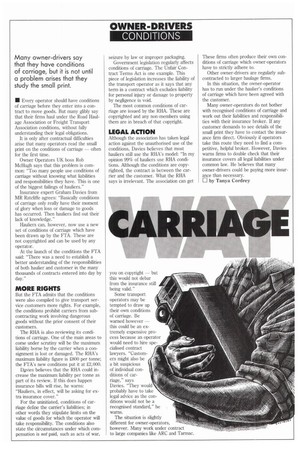CARRIAGt
Page 36

If you've noticed an error in this article please click here to report it so we can fix it.
Many owner-drivers say that they have conditions of carriage, but it is not until a problem arises that they study the small print.
IN Every operator should have conditions of carriage before they enter into a contract to move goods. But many glibly say that their firms haul under the Road Haulage Association or Freight Transport Association conditions, without fully understanding their legal obligations.
It is only after contractual difficulties arise that many operators read the small print on the conditions of carriage — often for the first time.
Owner Operators UK boss Rob McHugh says that this problem is common: ''l'oo many people use conditions of carriage without knowing what liabilities and responsibilities they have. This is one of the biggest failings of hauliers."
Insurance expert Graham Davies from MR Ratcliffe agrees: "Basically conditions of carriage only really have their moment of glory when loss or damage to goods has occurred. Then hauliers find out their lack of knowledge."
Hauliers can, however, now use a new set of conditions of carriage which have been drawn up by the FTA. These are not copyrighted and can be used by any operator.
At the launch of the conditions the FrA said: "There was a need to establish a better understanding of the responsibilities of both haulier and customer in the many thousands of contracts entered into day by day."
MORE RIGHTS
But the VIA admits that the conditions were also compiled to give transport service customers more rights. For example, the conditions prohibit carriers from subcontracting work involving dangerous goods without the prior consent of their customers.
The RHA is also reviewing its conditions of carriage. One of the main areas to come under scrutiny will be the maximum liability borne by the carrier when a consignment is lost or damaged. The RHA's maximum liability figure is 2800 per tonne; the FTA's new conditions put it at £2,000.
Davies believes that the RHA could increase the maximum liability per tonne as part of its review. If this does happen insurance bills will rise, he warns: "Hauliers, in effect, will be asking for extra insurance cover."
For the uninitiated, conditions of carriage define the carrier's liabilities; in other words they stipulate limits on the value of goods for which the operator will take responsibility. The conditions also state the circumstances under which compensation is not paid, such as acts of war,
seizure by law or improper packaging.
Government legislation regularly affects conditions of carriage. The Unfair Contract Terms Act is one example. This piece of legislation increases the liability of the transport operator as it says that any term in a contract which excludes liability for personal injury or damage to property by negligence is void.
The most common conditions of carriage are issued by the RHA. These are copyrighted and any non-members using them are in breach of that copyright.
LEGAL ACTION
Although the association has taken legal action against the unauthorised use of the conditions, Davies believes that most hauliers still use the RI-IA's model: "In my opinion 99% of hauliers use RHA conditions. Although the conditions are copyrighted, the contract is between the carrier and the customer. What the RHA says is irrelevant. The association can get you on copyright — but this would not debar from the insurance still being valid."
Some transport operators may be tempted to draw up their own conditions of carriage. Be warned however — this could be an extremely expensive process because an operator would need to hire specialised contract lawyers. "Customers might also be a bit suspicious of individual conditions of carriage," says Davies. "They would probably have to take legal advice as the conditions would not be a recognised standard," he warns.
The situation is slightly different for owner-operators, however. Many work under contract to large companies like ARC and Tarmac. These firms often produce their own conditions of carriage which owner-operators have to strictly adhere to.
Other owner-drivers are regularly subcontracted to larger haulage firms.
In this situation, the owner-operator has to run under the haulier's conditions of carriage which have been agreed with the customer.
Many owner-operators do not bother with recognised conditions of carnage and work out their liabilities and responsibilities with their insurance broker. If any customer demands to see details of the small print they have to contact the insurance firm direct. Obviously if operators take this route they need to find a competitive, helpful broker. However, Davies warns firms to double check that their insurance covers all legal liabilities under common law. He believes that many owner-drivers could be paying more insurance than necessary.
III by Tanya Cordrey








































































